Chapter 4
Getting Across Non-standard Intersections
Not all intersections are of the standard, “crossroads” type. Though the same principles of lane positioning apply to all intersection maneuvers, some situations can be confusing and deserve a second look.
Entering the Road
Bicyclists sometimes will ride against traffic or take unusual routes across intersections to get started on their way. Don’t do it!
Instead, look for a good place to enter, where you can start out with a normal intersection maneuver: a left or right turn, or a lane change to merge into traffic. The traffic laws apply as soon as you’re on the road, and even if you have to walk your bike a short distance; a legal start is much safer. Besides, you often get started faster, since you can then move with the normal flow of traffic.
When entering the road from a narrow driveway, ride down its middle. A pedestrian could be approaching on the sidewalk from either side, and a car could be about to enter the driveway from either direction. By placing yourself in the middle, you can see in both directions equally well.
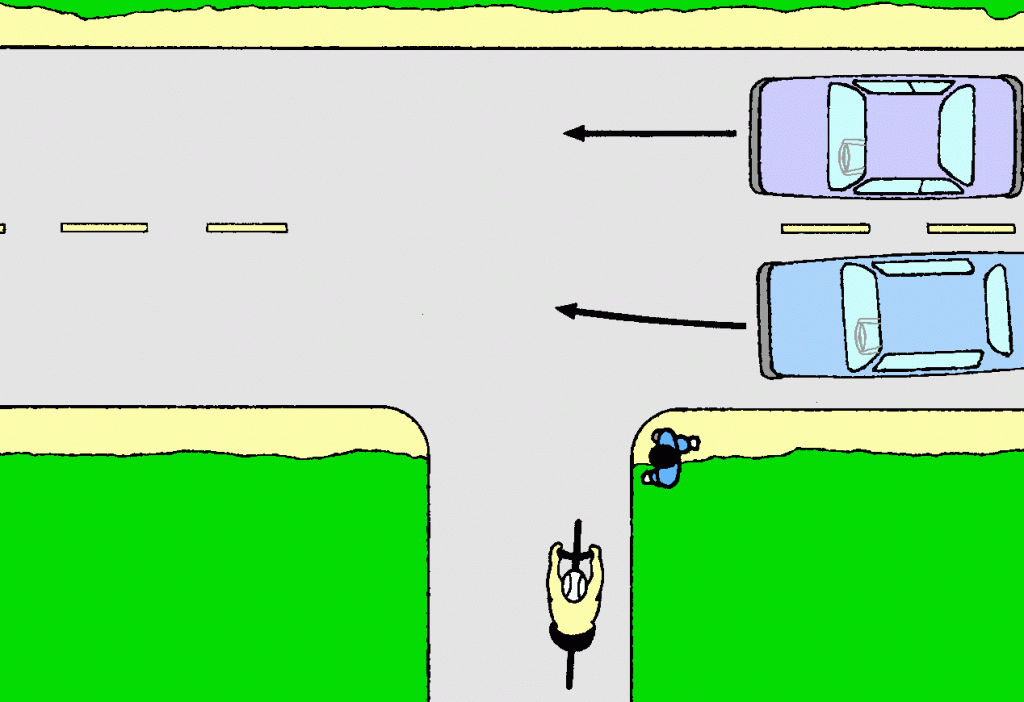
When entering the road, look left, but always look right as well for pedestrians and overtaking cars.
Even when preparing for a right turn onto a rural highway, look left, right, left, and then right again. A car approaching from your right can pull out to pass very quickly and head for you in the lane you’re about to enter.
Diagonal Intersections
Traffic follows the usual rules at a diagonal intersection, but it’s harder for drivers to look into the diagonal cross street behind them. Be especially careful of large vehicles with a big right rear blindspot.
Some of the turns in a diagonal intersection aren’t very sharp, so cars may not slow down very much. Be alert to oncoming left-turning traffic, and be sure the drivers have seen you.
On- and Off-ramps
When an on-ramp comes in from the right, you have two options: If speeds are modest, you may stay in your normal lane position, but be watchful of merging with entering traffic. With a high-speed on-ramp you may look back into it, merge across to the right and follow it back onto the main roadway. Sometimes a bike lane is marked to encourage this practice. Before you cross, be very careful that no traffic is approaching on the ramp.
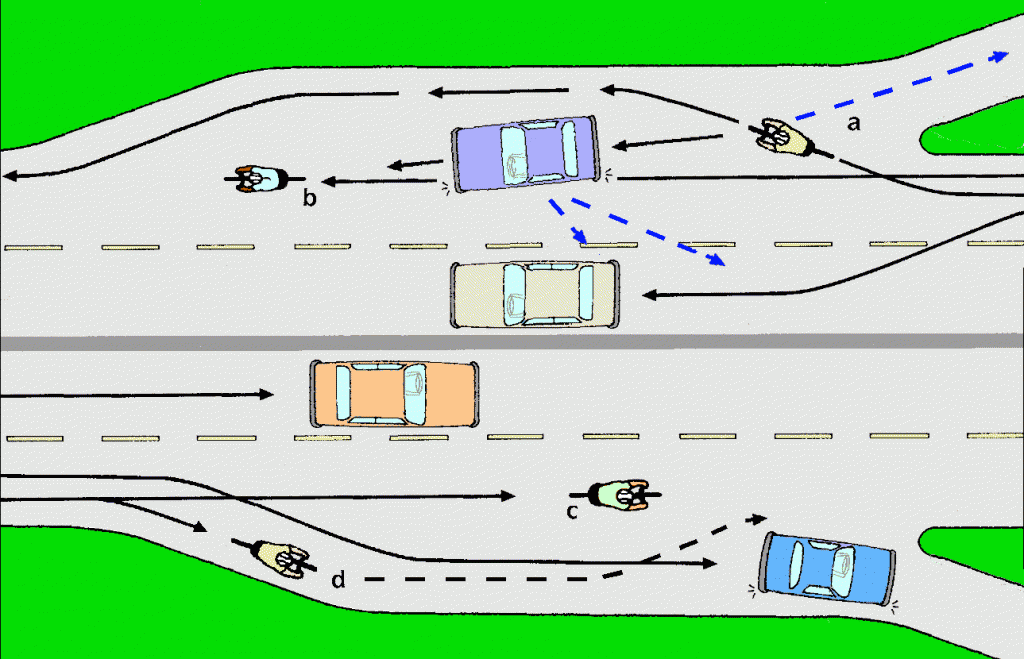
If passing a high-speed on-ramp as in (a), you are safest if you look right and carefully merge to its right edge. Cyclist (b) is at risk because the motorist behind him is looking back for traffic. His path is more direct, but is advised only under lower-speed conditions. With a high-speed off-ramp, it is often advisable to proceed as in (d) and merge back if continuing on the main roadway. With a lower-speed off-ramp, you may keep your position as in (c), avoiding the need to merge right and then left again.
An off-ramp is much like a right-turn lane, except that the traffic is faster. Again you have more than one option for going straight: In lower-speed conditions, stay in your normal position, to the left of the ramp. Exiting traffic will pass on your right, and through traffic will pass on your left. Exiting drivers may hesitate to pass you on the right. It’s effective to make a left turn signal and merge a little farther to the left than usual to alert motorists that you are not exiting. With a high-speed road – such as a bicycle-legal limited access highway, where you may temporarily lose your riding position on the shoulder – you may prefer to follow the ramp’s right side as if exiting, and then cross back to the main road before the ramp separates. Be very sure that you can see far enough back along the highway – you can’t always know whether a vehicle is exiting. A third option at some interchanges is to exit on the ramp and then reenter the highway.
A one-way roadway can have on- and off-ramps to the left side. When entering or exiting from the left in slower traffic, you may ride on the right side of the ramp, so you avoid having to cross as many lanes. When entering high-speed traffic on a ramp from the left, ride along its left side, then the left side of the roadway until you can merge across to your normal lane position. Similarly, when exiting on a high-speed ramp to the left, cross to the left before the ramp and ride on the left side of the ramp until it is safe to move to your normal lane position.
Sometimes two roadways will join or divide, but the total number of lanes will stay the same: follow the same advice as for ramps to avoid having to ride in between streams of high-speed traffic.
Traffic Circles, Roundabouts
Traffic circles and roundabouts are, in effect, left-curving one-way streets with several side streets to the right. All traffic turns right when entering or exiting. Entering vehicles yield to those already in the circle. The modern roundabout is designed to reduce vehicle speeds to improve safety for all users. The rest of this section applies to all but the largest, old-style traffic circles that are more like high-speed highways. For those you can use the techniques for on- and off-ramps.
When entering the circle, keep right if you’re going to turn right at the first exit. If going past the first exit, merge toward the inside – in a two-lane roundabout, you may move into the inner lane. It sometimes helps to make a left-turn signal while in the inner lane; drivers then feel comfortable about passing you on the right as they exit.
Because of the left curve, entering and exiting traffic go more nearly straight, and faster. For this reason, it is especially dangerous to pass an entrance or exit at the outside of the circle. Stay far enough left to keep clear of entering and exiting traffic. Merge back to the right as you approach your exit, using your normal tactics and hand signals. Stay alert for entering vehicles, and clear of large vehicles needing more space.
Bicyclists who always keep to the right will tell you that traffic circles and roundabouts are very dangerous. On the other hand, you’ll find it surprisingly easy to ride around most circles if you keep away from exits and entrances when not using them. Except in the very large high-speed circles, drivers don’t go very fast near the center, since they follow the curve.
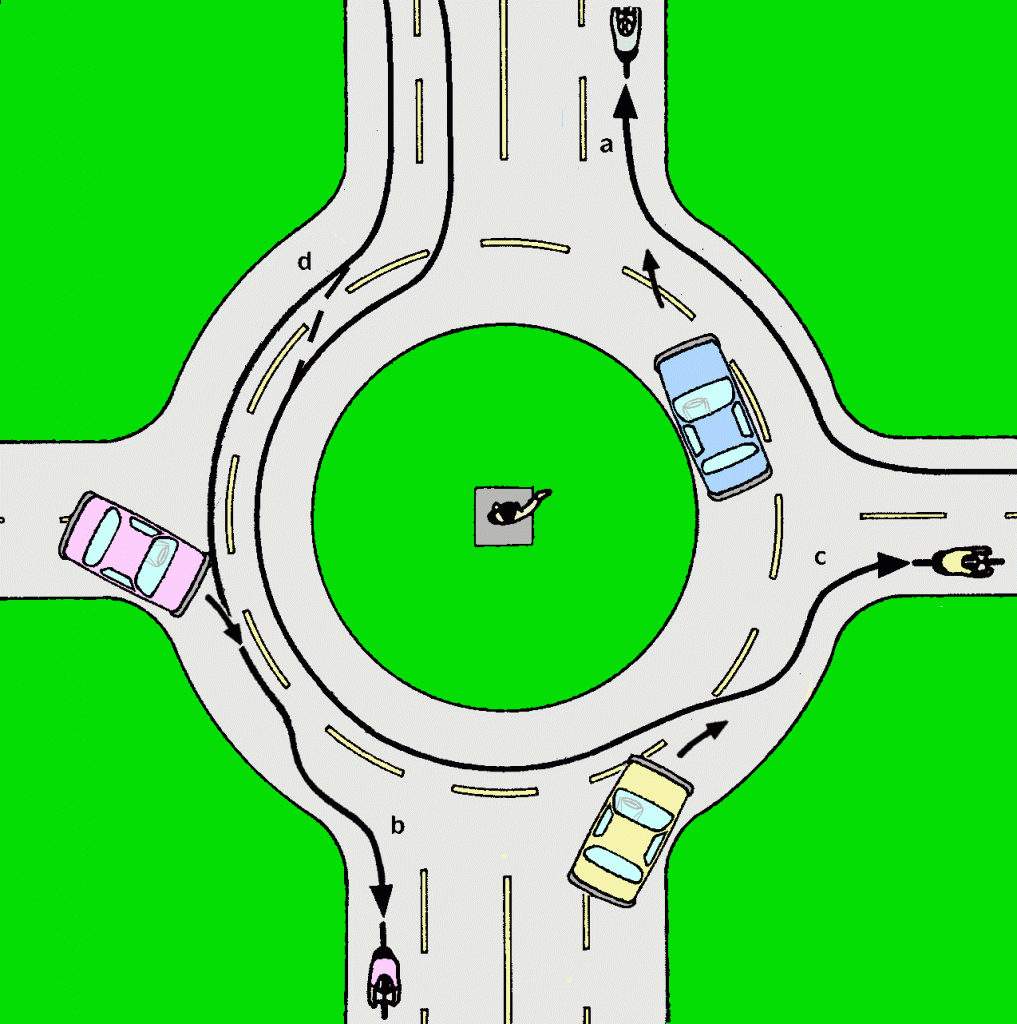
Roundabout: Stay in the outer lane if you will take the first exit, as in (a). Ride at the left side of the outer lane if going halfway around, as in (b). Ride in the lane closer to the center if going 3/4 of the way around, as in (c). In some roundabouts it is also legal to change lanes after entering, as at (d).
If you are not comfortable riding through a traffic circle or roundabout, dismount before entering and walk your bicycle around the outside, using sidewalks and crosswalks.
Two Left Turns in a Row
Sometimes you need to make two left turns quickly, one after the other; for example, if you’re turning left at an intersection and then turning left into a driveway at the middle of the block.
In this case, don’t head for the right side of the street after the first left turn. You may not have time to change lanes to the left again. Finish your first left turn in the correct lane to begin your second left turn.
Left Turns on One-way Streets
If a one-way street is two or more lanes wide, laws in most places allow you to ride at either side. When you turn left from a one-way street onto another one-way street, it’s easiest and safest to ride around the corner on the left – [John Alle1] the mirror image of a normal right turn.
Bike Lanes at Intersections
Bike lanes give bicyclists a narrow lane to the right of motorists. You may have to ride at the extreme edge of a bike lane to be clear of opening car doors. Sometimes you must ride outside the bike lane to be safe, especially at intersections, or if the next lane is narrowed and invites “brush-by” overtaking. Pass slower vehicles on the left. If you pass a vehicle on the right, it might turn right without the driver’s ever seeing you, and it also hides you from oncoming drivers who might turn left in front of you.
When turning left, merge left before the intersection as described in chapter 3. When going straight through, don’t let right-turning traffic get on your left and “hook” you. Unless the bike lane goes to the left of a right turn lane, this means moving left (out of the bike lane) before the intersection, merging into line with the cars. In the USA standard bike lane striping is dashed prior to intersections with signals or heavy right-turn volume, to encourage straight-through bicyclists and right-turning motorists to merge well before the intersection. When turning right, you can usually stay in the bike lane.
Some motorists may think that the bike lane is “your space” and you should stay in it. Your safety is more important. Bike lane or not, follow the lane positioning guidelines in this booklet.
Bike Boxes
Bike boxes are bicycle waiting areas. They attempt to make cycle traffic flow more smoothly when there is heavy motor traffic. There are two kinds.
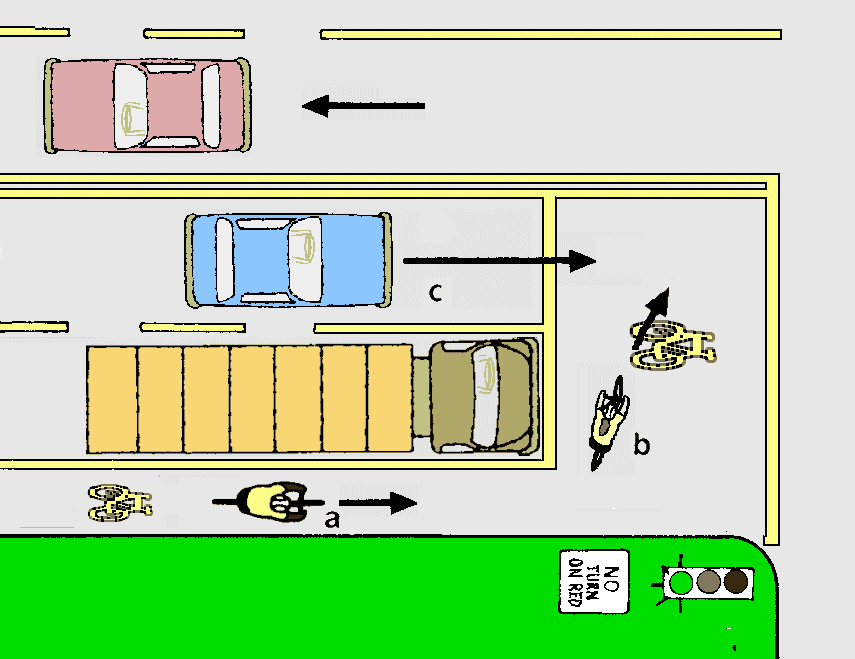
The traffic light has just turned green for bicyclist (a), but he cannot safely proceed or swerve into the bike box - the truck could start moving and may turn right. The truck hides bicyclist (b) from the driver of car (c) which is accelerating. The hood of the truck may also hide bicyclist (b) from the truck driver. Avoid these risks unless you are sure that the light is not about to turn green.
An in-line bike box or bicycle waiting area (only at a signalized intersection) has two stop lines: one for motorists and one closer to the intersection for bicyclists. The waiting area is between the stop lines. If the light is green the bike box has no effect – continue through the intersection normally. When the traffic light is red, the bike box invites you to filter forward and wait in front of the first motor vehicle. As always, only filter forward very slowly, even in a bike lane. You often will be at risk from opening car doors, crossing pedestrians, and vehicles crossing through gaps – see “Getting Through Traffic Jams” in chapter 9. Only pass the first vehicle on the right if you are sure the light will not change and the motorist won’t suddenly turn right, and never pass a long truck or bus in a narrow space. If the bike box is more than one lane wide, beware of entering a new lane. A vehicle in the lane you are crossing may conceal another vehicle approaching at speed as the light turns green.
A cross street bike box provides a waiting area for a two-step left turn. You cross the intersection to the far-right corner, where the bike box is placed ahead of the crosswalk in the cross street. You enter and then turn left in the bike box, and you are now in position to go straight though the intersection when the traffic signal changes to green. This can be more practical for left turns across a very busy and congested street. If the two-step turn is mandatory, however, it can delay you when traffic is lighter.
Summary
And there they are – the difficult intersection types. Once you can handle these, you can ride just about anywhere. You can even figure out how to handle intersections not described here by using the principles of lane changing and positioning on which all intersection maneuvers are based.
[John Alle1]Add to other versions…

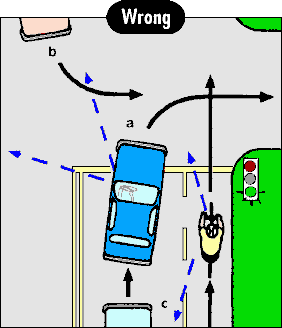
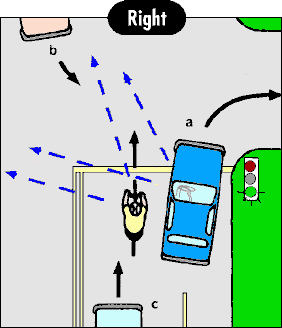
[Ramps illustration: make curves shallow so can be high or low speed ramps; D doesn’t show merging back; maybe show the rest of the path with a dashed line?]
Roundabout illustration:[?replace illustration with updated version of AZ roundabout illustration? AR to look into this. Otherwise, if using this illustration: Move letter B closer to path of cyclist; move letters A & C near path ala B instead of near cyclist; Move letter D close to dotted line; change ABCD to lower case.
Andy said: “possible” => “legal” after Ohio people pointed out that FWHA implies no lane changing allowed in (presumably the latest incarnations) of modern roundabouts. In these cases it is (as reported by Tricia in Ohio) posted as illegal to change lanes in the roundabout.. See point 5 under “Education is key” near the end of this page where it says “Stay in your lane within the roundabout”:
http://safety.fhwa.dot.gov/intersection/roundabouts/fhwasa08006/
[Bike box illustration (inverted with relation to these comments): starting with this illustration: http://bikexprt.com/bikepol/facil/images/npbikebox.gif on the page: http://bikexprt.com/bikepol/facil/stopline.htm edit as follows:
(1) move blue car at upper left down one lane and add arrow showing direction of travel.
(2) crop to use only lower-left portion including lane with newly-moved blue car.
(3) replace traffic light at near-right corner with green light in orientation for truck.
(4) if “no turn on red” sign remains, group words “on red” on 3rd line for better legibility.
(5) Move cyclist (a) back a bit towards the rear of the truck.
(6) Mark blue car heading toward bike-box as car “d” and move it back a little further, maybe ¼ to 1/3 car-length to emphasize that it’s moving and to make sight-line problem more obvious.
Replace traffic circles with roundabouts and show
a diagram of a cyclist going straight (in right lane) and
left (in left lane). We’re not permitted to change lanes
in the roundabout (although that is not law, it’s just
engineering rules).